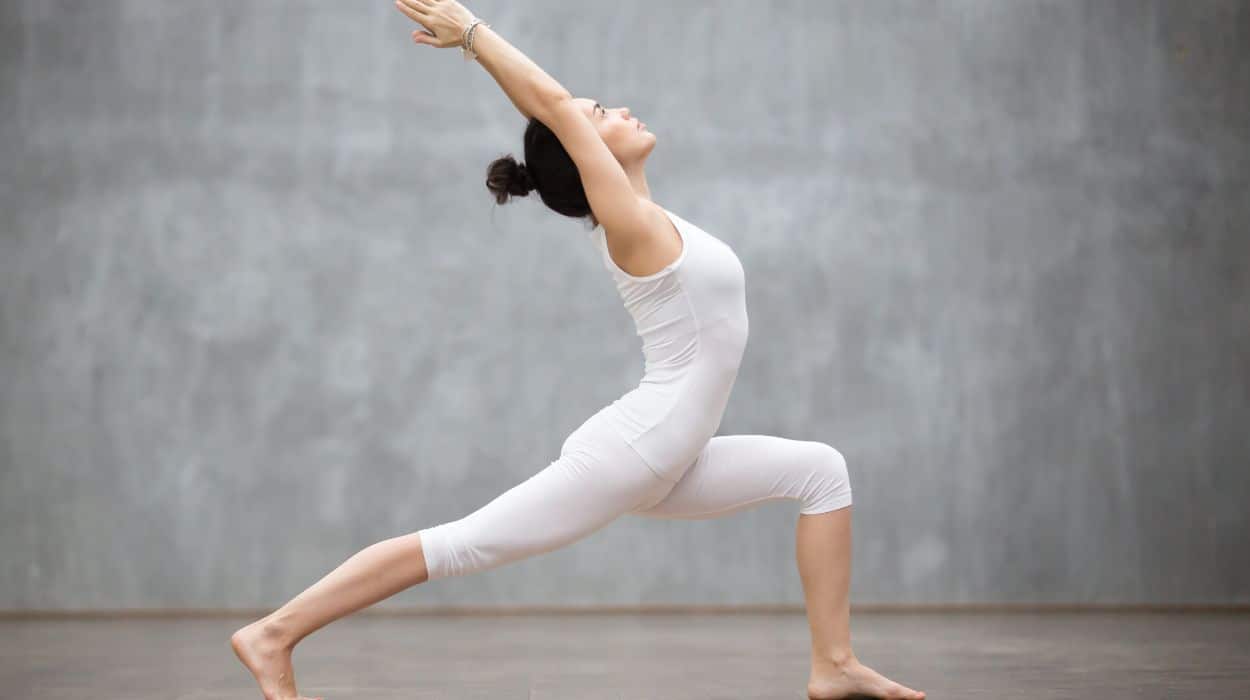Are you looking for an effective way to help you lose weight that doesn’t involve intense workouts or strict diets? Yoga may be the answer.
Yoga may not be the first thing that pops into your mind when you think about exercise for weight and body fat loss. However, research shows[1] that this low-impact activity delivers results equal to or superior to standard exercise.
This article will explore how yoga can help you lose weight and keep it off. We’ll also provide tips on how to get started and promote weight loss with a yoga class or practice at home.
Is Yoga Good For Weight Loss?
The short answer is yes, yoga can be a great weight-loss tool!
Yoga offers a range of physical and mental benefits[2] that can aid in weight loss efforts. Benefits include improved mindfulness around healthier eating habits, stress management, muscle building, digestion, metabolism, and overall well-being.
Does Yoga Help You Lose Weight?
Yes! Yoga is often associated with relaxation and stress relief, but it can also be a powerful tool for weight management. While it may not be the most intense form of exercise, yoga offers a range of physical and mental benefits that can aid in weight loss efforts.
Yoga Can Help With Mindful Eating
One of the main benefits of yoga for weight loss is its ability to help with mindful eating. Regular yoga practice can help to increase awareness of the body and eating habits, leading to healthier food choices, portion control, and a more balanced relationship with food.
Yoga Can Help You Manage Stress
Yoga is known for its stress-relieving benefits,[3] and regular practice can help to reduce stress levels and improve overall mental health. Stress can be a major obstacle to weight loss, as it can lead to emotional eating and other unhealthy behaviors.
Yoga Can Tame Belly Fat
Stress also contributes to fat gain in the abdomen,[4] which is both the most dangerous fat to have and the hardest to get rid of.
Yoga Helps Build Muscle
Yoga may not be the most traditional form of strength training, but it can still be an effective way to build muscle. Many yoga poses require holding the body in challenging positions, which can help to build strength and improve overall body composition.
Yoga Can Increase Metabolism
Certain types of yoga, such as Power Yoga or Ashtanga Yoga, can help to increase metabolism and burn calories more effectively. These practices involve more vigorous movements and sequences that raise heart rate and challenge the body.
Yoga Can Improve Digestion
Certain yoga poses can help stimulate digestion and improve gut health, aiding in weight loss. Poses like twists and forward folds can help massage the internal organs and improve digestion[5] while treating the stress and anxiety that may contribute to inflammatory disease.
Yoga Can Build Endurance And Self-Control
In addition to its physical benefits, yoga can help build endurance and self-control. Regular practice can help to improve focus and mental clarity, making it easier to stick to a healthy diet and exercise routine.
Yoga Can Improve Your Sleep And Overall Wellbeing
It’s well established[6] that yoga benefits sleep quality and psychological health. Perhaps most importantly, yoga can help to improve overall physical and mental well-being. Regular practice can lead to a more positive outlook and a healthier lifestyle, reducing stress, aiding in weight loss efforts, and improving the overall quality of life.
While yoga may not be a traditional form of weight loss exercise, it can still be effective for those looking to shed pounds and improve overall health and well-being. By practicing yoga regularly and combining it with a healthy diet and exercise routine, individuals can achieve their weight loss goals and improve their overall quality of life.
How Often Should You Do Yoga For Weight Loss?
As mentioned earlier, regular practice is vital to seeing results from yoga. Therefore, try to practice yoga several times a week and maintain a consistent schedule to see the most benefits.
Doctors recommend 30 minutes per day of activity. Just a 15-minute routine morning and evening can fulfill that goal.
How To Lose Weight With Practicing Yoga?
If you’re interested in using yoga as a tool for weight loss, here are some tips to get started:
Combine Yoga With A Healthy Diet
While yoga can be a powerful tool for weight loss, it’s important to remember that healthy eating plays a crucial role in weight loss. Combining a regular yoga practice with a healthy, balanced diet can help you achieve your weight loss goals more effectively.
Aim For Regular Yoga Practice
Aiming for regular practice is essential. Daily practice will help build strength, flexibility, and endurance, allowing you to progress over time.
Of course, you’ll still see some benefit from attending restorative yoga classes once or twice weekly. But your optimal results will come from exercising at least every other day.
Pick A Style You Enjoy
Yoga has many styles and applications. The #1 way to sabotage your exercise program is to pick activities you hate.
Instead, give your whole body some time to adjust to each new workout. If you’re miserable for every moment, consider why and try something different.
Here are some of the most popular types of yoga for weight loss and many health benefits:
Ashtanga Yoga
Ashtanga yoga is a physically demanding practice that involves a set series of poses performed in a specific order. This practice can help build strength and flexibility while improving balance and concentration.
Bikram Yoga
Also known as “hot yoga,” takes place in a heated room and involves a series of 26 yoga poses and two breathing exercises. This practice can increase flexibility, burn calories, and detoxify the body.
Hatha Yoga

Hatha yoga is a popular style that focuses on balancing the mind and body through physical postures (asanas), breathing exercises (pranayama), and meditation. It can improve flexibility, muscle strength, endurance, balance, coordination, posture, and stress management.
Iyengar Yoga
Iyengar yoga is a slower-paced practice that focuses on precise alignment and the use of props to support the body. It can build strength and flexibility while improving posture and relieving stress, and mental health.
Vinyasa Yoga

Vinyasa yoga is a fast-paced practice that links breath with movement. It often includes sequences of sun salutations and other flowing movements that can raise heart rate and improve cardiovascular health. This practice can also build strength, flexibility, and coordination.
Fusion Yoga Practices
Fusion yoga practices blend elements of yoga with other forms of exercise, such as Pilates, strength training, and dance. These practices often incorporate more intense movements and sequences that raise heart rate and challenge the body. Examples include:
- AcroYoga combines yoga, acrobatics, and Thai massage involving partner work and synchronized movements.
- Aerial Yoga involves performing poses while suspended from a fabric hammock or swing. It’s particularly beneficial for individuals with back and neck problems.
- PiYo is a high-intensity workout that combines pilates and yoga-inspired moves with dynamic strength training exercises that increase muscle mass and improve flexibility.
- Power Yoga is a dynamic and fast-paced practice that combines strength-building poses with cardio exercises. Power Yoga can help increase endurance, build muscle mass, and burn calories.
- Praise Moves is a Christian alternative to traditional yoga. For those uncomfortable with appropriating Hindu spiritual practices, this practice incorporates scripture readings and Christian worship music into yoga-inspired movements.
- Yogalates is a fusion of yoga and Pilates, this practice combines the stretching and mindfulness of yoga with the core strengthening and toning of Pilates. It can help improve posture, build strength and flexibility, and burn calories.
Remember that while healthy weight loss may be a goal for some, all types of yoga can provide physical and mental benefits. Choose a comfortable and enjoyable practice that suits your needs and interests, and practice regularly for the best results.
How To Begin Doing Yoga At Home
If you’re new to yoga or need access to a yoga studio, practicing at home can be a great option. Here are some tips for getting started:
Find A Quiet Space
To create a calm and peaceful atmosphere for your yoga practice, find a quiet space in your home where you can practice without distractions.
Invest In A Good Yoga Mat
A comfortable and supportive yoga mat is essential for safe and effective practice. Look for a mat that is non-slip and provides good cushioning for your joints.
Use Online Resources Or Videos
Many online resources and videos are available for practicing yoga at home, including beginner-friendly sequences and tutorials.
Some Yoga Poses To Try At Home
If you’re new to yoga or looking for some inspiration, here are a few beginner-friendly poses to try:
Mountain Pose With Upward Stretch
This pose promotes good posture and alignment while stretching and strengthening the entire upper body. In addition, it can help improve focus and concentration, calm the mind, and reduce stress.
- Start by standing with your feet hip-width apart and your arms at your sides.
- Inhale and reach your arms towards the ceiling, stretching your body upwards before arching your back and pointing to the wall behind you.
- Hold a few breaths
- Exhale and release your arms back down.
Forward Fold
This pose stretches the hamstrings and lower back while calming the mind and relieving stress. It can also improve digestion and circulation and promote relaxation and mental clarity.
- Stand with your feet hip-width apart
- Fold forward at the hips, letting your head hang down towards the ground. You can bend your knees slightly if needed
- Hold for a few breaths
- Slowly roll back up to standing
Downward-Facing Dog
This pose stretches the hamstrings, calves, and spine and strengthens the arms and shoulders.
- Start on your hands and knees, with your wrists directly under your shoulders and your knees under your hips.
- Exhale and lift your knees off the ground, pushing your hips up and back toward the ceiling. Keep your arms straight and try to extend your heels to the ground.
- Hold for a few breaths
- Release back down to your hands and knees
Low Lunge
This pose stretches the hip flexors, hamstrings, and quads and can help to improve balance and stability.
- Start in a plank pose, with your hands directly beneath your shoulders and your body balanced on your toes or your knees, like you’re at the top of a push-up.
- Step forward, moving one foot between your hands.
- Lower your back knee to the ground (if it’s not there already) and lift your torso upright, reaching your arms towards the ceiling. Keep your front knee bent at a 90-degree angle and your back foot flat on the ground.
- Hold for a few breaths. For a more intense stretch, reach backward, arching your back.
- Release and switch sides or transition to the next pose.
Warrior II
This pose strengthens the legs and core and can help to keep muscle tone and improve balance and stability.
- Start in a low lunge position, with one foot forward and the other foot back.
- Rotate your back foot parallel to the back of your mat.
- Inhale and lift your torso, reaching your arms out to the sides. Keep your front knee bent at a 90-degree angle and gaze over your front hand.
- Hold for a few breaths.
- Release and switch sides.
Tree Pose
This pose improves balance and strengthens the legs and abdominal muscles, promoting focus and concentration.
- Stand with your feet hip-width apart and shift your body weight onto one foot.
- Lift your other foot and place it on the inner thigh of your standing leg.
- Press your foot and thigh together and bring your hands to your heart center. You can reach up and hold your hands above your head, if comfortable. If you can’t balance yet, hold onto the back of a chair for balance.
- Hold for a few breaths
- Release and switch sides
Remember to breathe deeply and listen to your body as you practice these poses. If any pose feels uncomfortable or painful, back off and modify it as needed. With regular practice, you’ll feel more comfortable and confident in these poses and can gradually add more advanced poses to your practice.
Conclusion
Yoga can be a powerful tool for promoting how much weight loss when combined with a healthy diet and regular exercise routine. Practicing yoga can build strength, flexibility, and endurance while improving mindfulness, relieving stress, and boosting overall well-being.
Whether you practice yoga for weight loss at home or in a studio, aim for regular practice and choose a style that works for you. With dedication and consistency, yoga can help you achieve your weight loss goals and improve your overall health and happiness. So, why not give it a try and see what a consistent yoga practice can do for you?
Frequently Asked Questions
Thirty minutes of yoga daily can benefit weight loss, but it may not be enough to see significant results. Combining yoga with other forms of exercise and maintaining a healthy diet with restricted calories is also important for weight loss.
Yoga can help reduce belly fat by increasing overall body awareness, improving digestion, reducing stress, and strengthening the core muscles. While spot fat reduction in specific areas isn’t possible, yoga reduces stress hormones connected to fat accumulation in the abdomen.
Research shows that yoga is at least as beneficial as other types of exercise, if not more. The key is consistency. The best exercise for weight loss is whichever one you’ll stick with.
 Expert's opinion
Expert's opinion
